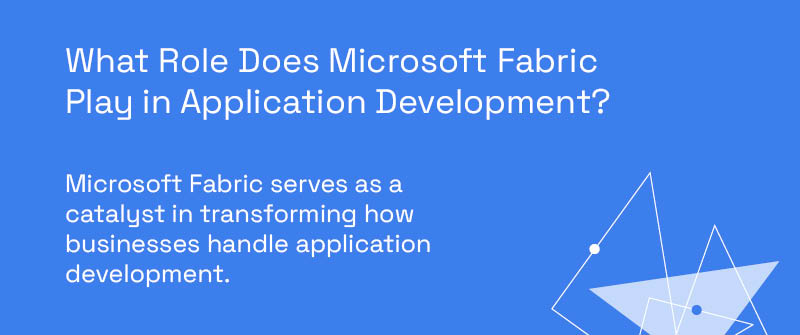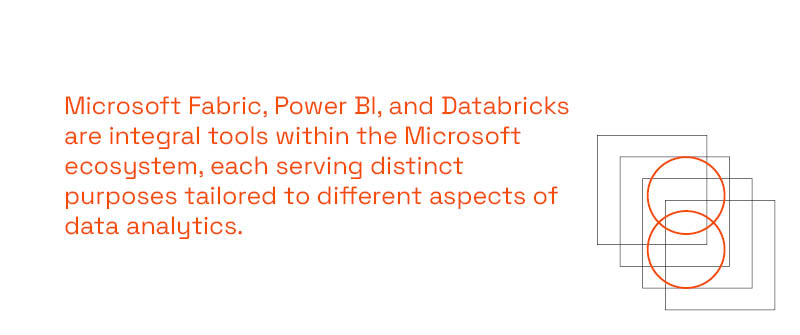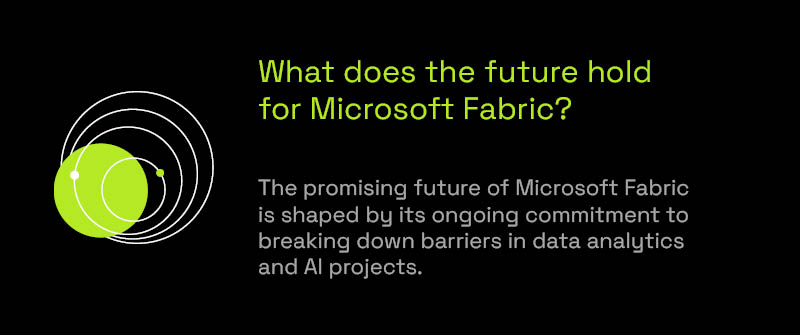
What Is Microsoft Fabric in Layman Terms?
At its core, Microsoft Fabric is a dynamic platform designed to simplify how businesses handle their data. Imagine it as a sophisticated toolkit that transforms raw data into meaningful insights, akin to turning raw ingredients into a gourmet dish through data engineering. It manages, processes, and analyzes large volumes of data, enabling better decision-making and operational efficiencies. Learn more about Microsoft Fabric Consulting.
Definition and Simplified Explanation
In layman’s terms, Microsoft Fabric is like a universal remote for your data. Data integration is a fundamental aspect of leveraging Microsoft Fabric, enabling businesses to combine data from various sources seamlessly. Instead of juggling different tools to collect, store, and analyze data, Microsoft Fabric provides a unified solution. This means that businesses can easily manage their data, no matter the source, and extract actionable insights that positively impact decision-making and strategy formulation.
Role in Data Integration, Management, and Analysis
The role of Microsoft Fabric in data management is akin to a robust organizational system. It facilitates data harmonization and data storage, effectively organizing scattered information into coherent structures ready for analysis. In terms of Microsoft Fabric data analytics, it acts as the engine that drives insights from data, utilizing advanced algorithms and analytics tools that offer businesses a deeper understanding of their operations and market trends.
Key Features and User-Friendly Tools
What makes Microsoft Fabric particularly user-friendly are its built-in features that simplify complex tasks. It is designed to simplify data management within organizations, eliminating data silos and enabling seamless access to analytical resources through its OneLake component. It encompasses user-friendly tools such as automatic data recovery and modular data structures, enabling even individuals with moderate technical skills to harness its power. These features ensure that businesses can continually adapt to challenges and opportunities in reality without being bogged down by technical complexities, leading to enhanced productivity and innovation.
What Is Microsoft Fabric Used For?
Microsoft Fabric is used for advanced data analytics, making it an indispensable tool for businesses striving to harness the power of their data. Its capabilities span from predictive analytics to real-time data processing, offering a dynamic range of functionalities that improve decision-making processes for organizations. Additionally, Microsoft Fabric facilitates the collection, processing, and analysis of streaming data to enhance analytics processes and enable faster decision-making for organizations.

In the realm of data analysis and predictive analytics, Microsoft Fabric empowers businesses to delve deeply into historical data, uncover trends, and forecast future outcomes with remarkable accuracy. Utilizing advanced machine learning capabilities allows organizations to anticipate changes and adapt their strategies accordingly, significantly enhancing their competitive edge.
Furthermore, one of Microsoft Fabric’s standout features is its proficiency in real-time data processing. Firms can now access and analyze current data instantly, facilitating timely and effective decision-making. This immediate access to data is crucial in fast-paced industries where market conditions can change rapidly, requiring businesses to be agile and responsive.
Integration with IoT and Third-Party Applications
The seamless integration capabilities of Microsoft Fabric with IoT devices and third-party applications significantly broaden its applicability. It also functions as a data factory, integrating various services, including Azure Data Factory, to facilitate data integration and analytics. It aggregates data from various sources, including IoT sensors, to provide a unified and comprehensive view of an organization’s operations. This integration fosters a more connected data environment, enhancing overall data visibility and enabling more informed insights.
Moreover, by combining data from numerous external applications, Microsoft Fabric delivers a holistic approach to data management and analytics. This capability provides businesses with a complete toolkit to streamline their data processes and generate actionable insights that can drive strategic initiatives and growth.
Why Do I Need Microsoft Fabric?
Microsoft Fabric offers an indispensable platform for businesses striving to enhance business efficiency and optimize decision-making processes. A unified data analytics platform, such as Microsoft Fabric, combines multiple functionalities like data warehousing and data lakes to streamline data integration, processing, and analysis. At its core, Microsoft Fabric is designed to simplify and accelerate application development and deployment while simultaneously providing flexibility in deploying applications either as cloud solutions or on-premises.
How Does Microsoft Fabric Enhance Business Efficiency?
By streamlining operations with automated tasks and providing robust disaster recovery capabilities, Microsoft Fabric positions itself as a powerful ally in the pursuit of operational excellence. By significantly reducing the time spent by data engineers on tasks like pipeline debugging and troubleshooting, the platform enhances the efficiency of data processes. The platform’s user-friendly tools and seamless integration with other Microsoft services substantially reduce manual intervention in routine tasks, allowing key personnel to dedicate their expertise to strategic initiatives rather than administrative burdens. The ability to segment applications into manageable components further supports efficient resource allocation and empowers organizations to adapt swiftly to evolving business needs.
What Role Does Microsoft Fabric Play in Application Development?
Microsoft Fabric serves as a catalyst in transforming how businesses handle application development. One of its key experiences is synapse data engineering, which facilitates various data workloads like data science, data warehousing, and real-time analytics. It simplifies the creation and deployment of applications by offering tools that support microservices architectures, thus enabling the development of scalable, resilient software solutions. Microsoft Fabric’s intuitive interface and robust support for various programming languages cater to both novice developers and seasoned IT professionals, facilitating smooth planning and execution of complex development projects.

Flexibility in Cloud and On-Premises Data Warehousing Deployment
Versatility is a hallmark of Microsoft Fabric, which offers unrestricted flexibility in deploying applications across cloud and on-premises environments. Azure Data Factory, a key component of Microsoft Fabric, plays a significant role in data engineering by facilitating the design and maintenance of data infrastructures, processing large data volumes, and generating insights. Whether your organization operates on a local server infrastructure, in the cloud, or a hybrid of both, Microsoft Fabric adapts to your strategic requirements. This adaptability is crucial for businesses seeking to maintain competitive advantages and is made even more attractive by its compatibility with other leading Microsoft products, delivering a cohesive ecosystem that drives applications and business outcomes alike.
What is the Difference Between Microsoft Fabric and Azure?
The fundamental differences between Microsoft Fabric and Azure stem from their focus and the scope of services they provide. Microsoft Fabric is designed specifically for data analytics with a suite of tools that focus on the processing, management, and analysis of data. A key component of Microsoft Fabric is the synapse data warehouse, which integrates with various data-related functionalities aimed at streamlining data warehousing, analytics, and machine learning processes. It excels in real-time analytics, data warehousing, and integrating machine learning models into workflows. In contrast, Azure offers a broader cloud computing platform that encompasses an extensive range of services that go beyond data analytics, such as virtual computing, application hosting, and more, serving as a comprehensive cloud infrastructure solution.
Comparison of Services and Capabilities
Microsoft Fabric is laser-focused on providing tools for efficient data management and analytics. It offers a specialized environment for organizations that need substantial data analytics capabilities, rapid deployment, and robust data warehouse solutions. Azure, however, presents a more generalized service offering that includes not just analytics but also virtual machines, artificial intelligence, Internet of Things (IoT) services, and many other cloud-based functionalities. This wide range of capabilities makes Azure a versatile choice for businesses needing a comprehensive cloud infrastructure.
Integration with Other Microsoft Tools
One of the key advantages of both Microsoft Fabric and Azure is their seamless integration with other Microsoft products, such as Power BI and Azure Data Lake Storage, which enhances their overall utility and appeal to businesses already operating within the Microsoft ecosystem. Synapse Data Science is a crucial component within Microsoft Fabric, facilitating data science and machine learning tasks. Microsoft Fabric particularly stands out for its streamlined architecture and user-friendly interfaces that allow for zero infrastructure management and swift onboarding. Azure provides the broader infrastructure needed to support these services.
Use Cases for Businesses
Organizations with heavy data analytics needs often gravitate towards Microsoft Fabric for its robust data processing capabilities and integration with machine learning models. Businesses looking for a comprehensive cloud-based solution that supports a wide array of operational requirements would find Azure more suitable due to its diverse offerings. While Fabric aids in deriving insights and analyzing data with precision, Azure scales easily across different areas, providing a backbone for various business processes from application development to IoT solutions.
Microsoft Fabric vs Power BI and Databricks
In the realm of data analytics and business intelligence, choosing the right tool is paramount for maximizing strategic value and growth. Microsoft Fabric is an integrated analytics platform that combines various services, including Azure Data Factory, to facilitate data integration and analytics. Two prevalent discussions center on Microsoft Fabric vs Power BI and Microsoft Fabric vs Databricks. While each of these platforms offers valuable features, understanding their key differences can help your organization make informed decisions.

Differences between Microsoft Fabric, Power BI, and Databricks
Microsoft Fabric, Power BI, and Databricks are integral tools within the Microsoft ecosystem, each serving distinct purposes tailored to different aspects of data analytics. A unified data analytics platform, such as Databricks, combines multiple functionalities like data warehousing and data lakes to enhance data integration, processing, and analysis. Microsoft Fabric is a comprehensive data platform that seamlessly integrates data ingestion, processing, and advanced analytics, positioning itself as a unifying force in data management and application development. On the other hand, Power BI excels at data visualization and business intelligence, offering tools that transform data into insightful reports and dashboards. While both reside within the same suite, Fabric serves as the backbone for broader data processing, whereas Power BI specializes in turning that processed data into visually engaging presentations. Meanwhile, Databricks is a platform renowned for its robust capabilities in large-scale data processing and machine learning, operating independently but capable of integrating efficiently with Fabric, offering businesses enhanced big data management and collaboration tools.
Strengths and weaknesses
Microsoft Fabric stands out with its seamless integration with multiple Azure services, offering a holistic approach to data analysis and application development. Its strength lies in providing a unified environment for handling intricate data tasks and efficient data storage while maintaining cost-efficiency, a crucial aspect for businesses leveraging Microsoft’s cloud services. However, its broad focus might not provide the specialized depth found in other tools.
Power BI, with its focus on data visualization, ensures that users can easily interpret data through robust visualization capabilities. However, its limitations are apparent when dealing with extremely large datasets or requiring complex data processing capabilities that are more aligned with Fabric or Databricks.
Databricks excels in its support for machine learning and data science functionalities. Its ability to handle complex data processing workflows is unparalleled, albeit at a higher operational cost, which might not be feasible for all business types.
Application scenarios
Organizations should align their choice of platform with their specific business objectives and operational needs. Data integration is crucial for leveraging Microsoft Fabric to optimize business processes and enhance data management. For enterprises seeking a comprehensive data solution with smooth integration into existing Microsoft infrastructure, Microsoft Fabric offers unparalleled value, particularly in contexts where rapid development and deployment are critical. Alternatively, industries primarily focused on data visualization and reporting might find Power BI most suitable. Finally, for businesses dealing with massive datasets and requiring advanced analytics, Databricks provides the ecosystem that nurtures innovation and insight through its collaborative and powerful data processing capabilities.
By precisely understanding the distinct capabilities and application scenarios of these platforms, business leaders and IT professionals can ensure that their chosen solutions align with their strategic business goals, maximizing ROI and fostering innovation across departments.
Conclusion and Future of Microsoft Fabric
Microsoft Fabric stands at the forefront of technological innovation, propelling businesses into a future where data analytics and integration are seamlessly unified. It facilitates the collection, processing, and analysis of streaming data to enhance analytics processes and enable faster decision-making for organizations. As the technology landscape continuously evolves, Microsoft Fabric ensures that its users are equipped with state-of-the-art tools for data management and analysis. Microsoft Fabric is more than just a tool; it’s a strategic partner in driving business growth and innovation.

What does the future hold for Microsoft Fabric?
The promising future of Microsoft Fabric is shaped by its ongoing commitment to breaking down barriers in data analytics and AI projects. Data engineers will find that Microsoft Fabric significantly reduces the time spent on tasks like pipeline debugging and troubleshooting, thereby improving overall productivity. Microsoft Fabric is designed to be a catalyst for transforming complex tasks into effortless processes. This platform will likely continue to innovate, incorporating more AI-driven insights, automating processes, and enhancing data-driven decision-making capabilities. Its roadmap points toward making advanced analytics accessible to a wider audience and democratizing data insights to empower more informed business strategies.
Why should businesses adopt Microsoft Fabric now?
Adopting Microsoft Fabric today positions your business at a strategic advantage, leveraging a unified platform that grows with your evolving needs. With integration capabilities that span across various Microsoft services and external applications, it acts as a cohesive force in your digital ecosystem. Businesses that adopt Microsoft Fabric can anticipate a transformative shift in how they handle data, leading to improved efficiency, more effective decision-making processes, and ultimately, a competitive edge in the market.
In conclusion, implementing Microsoft Fabric is not just about keeping up with technological trends; it’s about embracing a future of innovation and strategic growth. With its continued evolution and expansion, Microsoft Fabric is a robust solution that promises to redefine the data analytics and AI landscape, providing strategic value and driving growth across industries.
Elevate your business operations and future-proof your data strategy with Microsoft Fabric. Seamlessly integrate advanced analytics to achieve new levels of excellence and innovation. Harness the power of centralized data insights to transform your decision-making processes and gain a competitive edge in today’s digital world. Contact P3 Adaptive Today!
Get in touch with a P3 team member